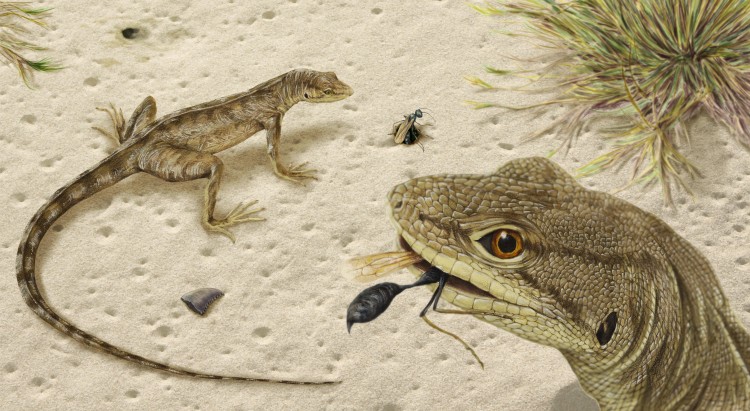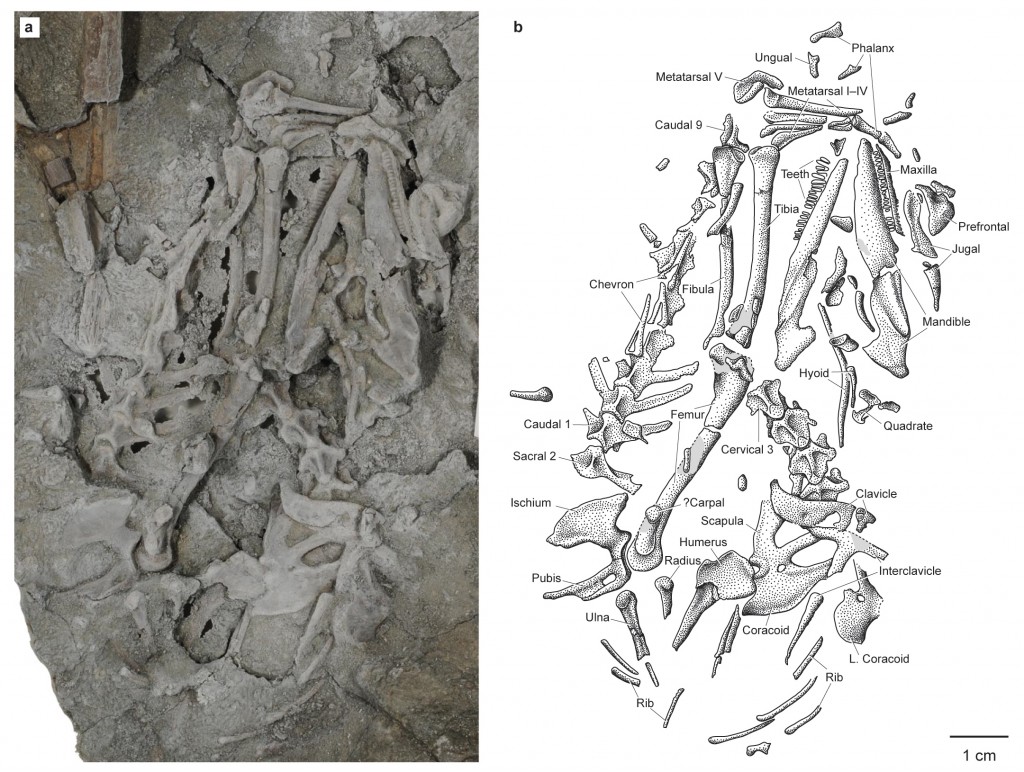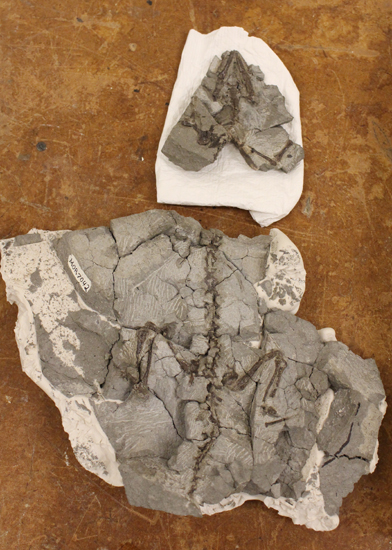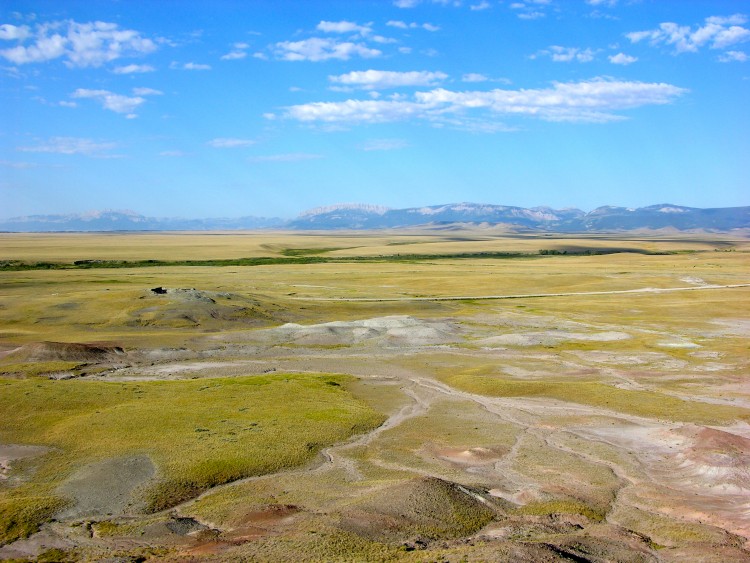The Oldest, Most Complete Iguanian of the Americas
Magnuviator ovimonsensis from Egg Mountain
Palaeontologists picking through a bounty of fossils from Montana have discovered something very unexpected, a new species of lizard from that lived near to the end of the Age of Dinosaurs, whose closest relatives roamed in faraway Asia.
Magnuviator ovimonsensis
This ancient lizard, which lived 75 million years ago in a dinosaur nesting ground, is described in a paper published this week in the academic journal “The Proceedings of the Royal Society B”. Named Magnuviator ovimonsensis, the new species fills in significant gaps in our understanding of how lizards evolved and spread during the Mesozoic, according to palaeontologists at the University of Washington and the Burke Museum of Natural History and Culture who led the research.
Postdoctoral research associate, David DeMar, lead author of the paper stated:
“It is incredibly rare to find one complete fossil skeleton from a relatively small creature like this lizard. But, in fact, we had two specimens, both from the same site at Egg Mountain in Montana.”
Magnuviator is reshaping how scientists view lizards, their biodiversity and their role in complex ecosystems during the Cretaceous some seventy-five million-years-ago.
An Illustration of Magnuviator ovimonsensis
Picture credit: Misaki Ouchida
The picture above shows a pair of Magnuviator lizards at the Egg Mountain fossil site. One Magnuviator eats a wasp, on the ground is a tooth from the bird-like, theropod dinosaur Troodon. The arid-adapted plant is based on fossil pollen found near Egg Mountain.
An Ancient Lineage of Iguanian Lizards
Based on analyses of the nearly complete fossil skeletons, Magnuviator was an ancient offshoot of iguanian lizards. The fossils are the oldest, most complete iguanian fossils from the Americas. Today, iguanians include chameleons of the Old World, iguanas and anoles in the American tropics. Based on its anatomy, Magnuviator was at best a distant relative of these modern lizard families, most of which did not arise until after the non-avian dinosaurs and quite a few lizards and other creatures became extinct some sixty-six million years ago.
The Holotype Fossil Material (M. ovimonsensis)
Picture credit: David DeMar and Morgan Turner
A Meticulous Study
The researchers came to these conclusions after a meticulous study of both Egg Mountain specimens over a period of four years. This included a round of CT scans at Seattle Children’s Hospital to narrow down the fossil’s location within a larger section of rock and a second round at the American Museum of Natural History to digitally reconstruct the skull anatomy.
The fact that both skeletons were nearly complete allowed the team to determine not only that Magnuviator represented an entirely new species, but also that its closest kin weren’t other fossil lizards from the Americas. Instead, it showed striking similarities to other Cretaceous iguanians from Mongolia.
The Second Magnuviator Fossil Specimen
Picture credit: Burke Museum of Natural History and Culture
DeMar commented:
“These ancient lineages are not the iguanian lizards which dominate parts of the Americas today, such as anoles and horned lizards. So, discoveries like Magnuviator give us a rare glimpse into the types of ‘stem’ lizards that were present before the extinction of the dinosaurs.”
A Resident of Egg Mountain
But Magnuviator’s surprises don’t end with the Mongolian connection. The site of its discovery is also astonishing. Egg Mountain is already famous among fossil hunters. Over thirty years ago, palaeontologists discovered the first fossil remains of dinosaur babies there, and it is also one of the first sites in North America where dinosaur eggs were discovered.
Senior author Greg Wilson (University of Washington, associate professor of biology), stated:
“We now recognise Egg Mountain as a unique site for understanding Cretaceous Period ecosystems in North America. We believe both carnivorous and herbivorous dinosaurs came to this site repeatedly to nest, and in the process of excavating this site we are learning more and more about other creatures who lived and died there.”
The team even named their new find as homage to its famous home and its close lizard relatives in Asia. Magnuviator ovimonsensis means “mighty traveller from Egg Mountain.”
A View of the Famous Fossil Location in Montana – Egg Mountain
Picture credit: David Varricchio
A distant view of Egg Mountain and the basin in which it lies. Egg Mountain is in the centre-left of this image, within the basin. Clearly visible at its top are black rectangular shapes, which are tarps erected near the excavation site
The Spectacular Egg Mountain Fossil Site
Through excavations at Egg Mountain led by co-author David Varricchio at Montana State University and meticulous analysis of fossils at partner institutions like the University Washington and the Burke Museum, scientists are piecing together the Egg Mountain ecosystem of around seventy-five million years ago. In those days, Egg Mountain was a semi-arid environment, with little or no water at the surface. Dinosaurs like the duck-billed hadrosaurs such as Maiasaura and the bird-like, carnivorous Troodon nested there.
To read about a study mapping the lives of a population of Maiasaura: Mapping the Lives of a Population of Plant-eating Dinosaurs.
The Egg Mountain Ecosystem
Researchers have also unearthed fossilised mammals at Egg Mountain, which are being studied by Wilson’s group, as well as wasp pupae cases and pollen grains from plants adapted for dry environments. Based on the structure of Magnuviator’s teeth, as well as the eating habits of some lizards today, the researchers believe that it could have feasted on wasps at the Egg Mountain site. Though based on its relatively large size for a lizard, in excess of thirty centimetres long, Magnuviator could have also eaten something entirely different. It might have been a herbivore.
Whatever its diet, Magnuviator and its relatives in Mongolia did not make it into the modern era. DeMar and co-authors hypothesise that these stem lineages of lizards may have gone extinct along with the non-avian dinosaurs. But given the spotty record for lizards in the fossil record, it will take more Magnuviator-level discoveries to resolve this debate, and, unfortunately, part of the excitement surrounding Magnuviator is that it is a very rare find.
Everything Dinosaur acknowledges the assistance of the University of Washington in the compilation of this article.
Visit the Everything Dinosaur website: Everything Dinosaur.





